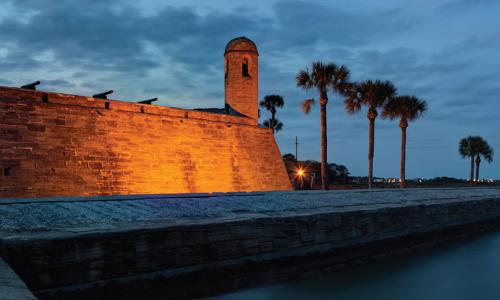This profile is excerpted from the 2014 report, "National Landmarks at Risk: How Rising Seas, Floods, and Wildfires Are Threatening the United States' Most Cherished Historic Sites."
The next major storm that hits Annapolis, MD, could cause extensive flooding and widespread damage to the city’s historic center. Because sea levels continue to rise in Chesapeake Bay, a so-called 100-year storm (a severe event with a 1 per-cent chance of occurring in any given year) would likely severely damage many historic structures in Annapolis, take years from which to recover, and seriously harm the city’s tourism economy.
Laid out in 1695, Annapolis was one of the first planned cities in the United States. Its historic core contains the country’s largest concentration of eighteenth-century brick buildings, including the Palladian-style Hammond-Harwood House, widely regarded as one of the finest colonial buildings in the United States. Settled in the mid-seventeenth century by non- conforming Protestants from Virginia and other religious independents, Annapolis later became the capital of the colony, and the state, of Maryland. The city’s eighteenth-century waterfront bustled with ships bringing visitors, immigrants, servants, and slaves to town. Imported goods from Europe, the Caribbean, and other colonies filled dockside warehouses.
All four of Maryland’s signers of the Declaration of Independence lived in Annapolis at one time or another, and the city was the first post-Revolutionary War capital of the United States, hosting the Continental Congress in 1783 and 1784. George Washington resigned his commission as commander of the Continental Army here in 1783, and the Treaty of Paris, which formally ended the war, was ratified in the State House in 1784. That building’s huge wooden dome—the largest in the nation—became a model in subsequent years for many other US state houses.
Annapolis is also known as the home of the U.S. Naval Academy. Founded as the Naval School in 1845, with an initial enrollment of about 50 students, most of its Beaux Arts–style historic buildings date from the early 1900s, including the chapel with its iconic dome. The body of John Paul Jones, one of the founding officers of the Continental Navy, lies in a crypt under the chapel.73 The famous flag carrying the words “Don’t give up the ship,” flown in 1813 by Admiral Oliver Hazard Perry at the Battle of Lake Erie, hangs in Memorial Hall.
Many of the places and structures that provide daily reminders of Annapolis’s rich history are today at risk because sea levels along the coast of Maryland are rising. During the last 20 years, sea level along the 620-mile Atlantic coastline north of Cape Hatteras, NC, has risen up to four times faster than the national average. According to scientists at the University of Maryland, Chesapeake Bay’s sea level could rise by another one to two and a half feet by the middle of this century. To make matters worse, warmer ocean temperatures are fueling stronger North Atlantic hurricanes. Storm surges associated with hurricanes and other storms have caused the water to ascend three feet or more above mean sea level at least 10 times in Annapolis during the last decade. Resulting damage can be expected to worsen in the future, as rising seas not only raise the frequency of floods from regular high tides but also increase the height of storm surges.
Tropical cyclones and nor’easters can bring powerful winds that push waters up against the head of Chesapeake Bay, potentially causing catastrophic flooding in Annapolis. Hurricane Isabel caused widespread and serious flooding in the city during September 2003, when water levels at the Naval Academy reached about six and a half feet above average, more than two feet over the current 100-year flood level; classrooms, laboratories, athletic facilities, residence halls, and the utility tunnels under the Nimitz Library were inundated, causing more than $120 million in damage. Since Hurricane Isabel, the Naval Academy has developed extensive flood-mitigation plans and implemented many measures to reduce damage and bolster resilience to future floods. Measures have included the installation of door and window dams, temporary flood walls, and check valves on tunnels. Belowground cisterns that capture storm water and slowly release it have been built to mitigate the impacts of flooding.
The storm surge from Isabel caused disastrous flooding in the historic City Dock area too, damaging dozens of buildings. It took a decade before the 1858 Market House was restored, reopening in 2013.
In addition to the threat of major storms, regular nuisance flooding in Annapolis is increasing as a result of sea level rise. Seven of the highest water levels since 1937 have occurred since 2000. Most of the area around City Dock is at just two to four and a half feet above sea level, and minor flooding begins when water levels reach 1.9 feet. At that point, storm drains begin to back up and water discharges from drain inlets.
The city is preparing for the inevitability of another major storm and, by 2050, for at least a doubling of high-tide flooding events. In order to ensure the preservation of the buildings and streetscape within the 100-year floodplain of the city’s Historic Landmark District, Annapolis is developing a Cultural Resource Hazard Mitigation plan—beginning with a comprehensive survey of all 140 at-risk buildings in the district—supported in part by the National Trust for Historic Preservation, the Maryland Historical Trust, and Preservation Maryland. Among the many important buildings close to the City Dock that the survey will include are the waterfront Tobacco Warehouse (early nineteenth century); Middleton Tavern (ca. 1750), from which renowned visitors including George Washington and Thomas Jefferson traveled by ferry across the bay; and the Sands House (ca. 1739), one of the city’s oldest and lowest-lying buildings. Annapolis’s pioneering approach to minimizing damage and disruption from future climate change is likely to become a model for other historic coastal cities.




